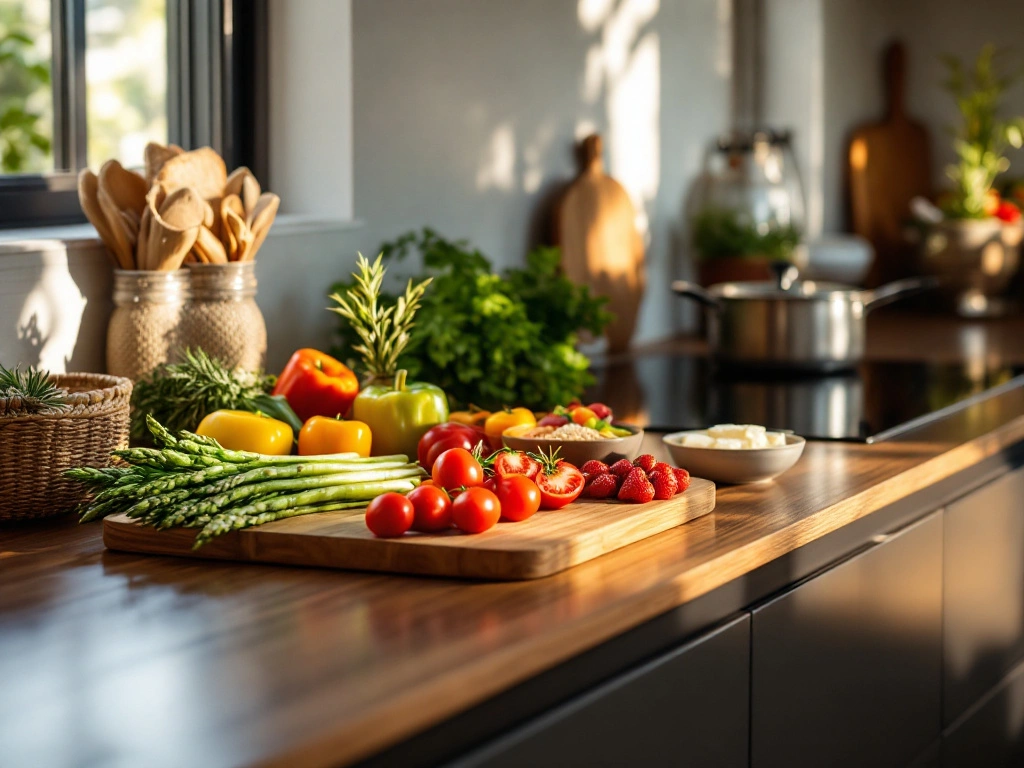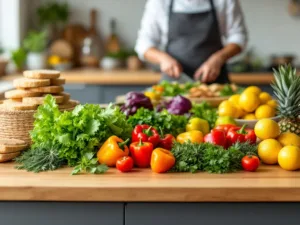How to Make Healthy Food Delicious: Tips and Secrets from Professional Chefs
Introduction
In a world where fast food and processed meals dominate our diets, the quest for healthy eating often feels like a daunting task. Many people associate healthy food with bland, unappetizing dishes that lack the flavor and satisfaction of their less nutritious counterparts. However, the truth is that healthy food can be just as delicious, if not more so, than any other type of cuisine. The key lies in understanding how to balance nutrition with flavor, and who better to guide us in this endeavor than professional chefs? In this article, we will explore the art of making healthy food delicious, drawing on the expertise of culinary professionals who have mastered the craft. From selecting the right ingredients to employing innovative cooking techniques, we will uncover the secrets that can transform your meals into a symphony of taste and health.
The Foundation of Flavor: Choosing the Right Ingredients
The Importance of Freshness
The first step in creating delicious healthy meals is selecting the right ingredients. Freshness is paramount when it comes to flavor. Fresh fruits, vegetables, herbs, and spices are not only more nutritious but also more flavorful than their canned or frozen counterparts. Professional chefs emphasize the importance of sourcing ingredients from local farmers’ markets or growing your own produce whenever possible. The closer the ingredient is to its natural state, the better it will taste.
Seasonal Eating
Eating seasonally is another crucial aspect of ingredient selection. Seasonal produce is harvested at its peak ripeness, which means it is packed with flavor and nutrients. For example, a tomato picked in the height of summer will have a much richer taste than one grown in a greenhouse during the winter. By aligning your meals with the seasons, you can ensure that your dishes are bursting with natural flavor.
Quality Over Quantity
When it comes to proteins, quality is just as important as freshness. Opt for grass-fed beef, free-range chicken, and wild-caught fish. These options are not only healthier but also more flavorful due to the animals’ natural diets and living conditions. While they may be more expensive, the investment in quality ingredients will pay off in the taste and nutritional value of your meals.
Mastering the Art of Seasoning
The Role of Herbs and Spices
Herbs and spices are the unsung heroes of healthy cooking. They add depth, complexity, and excitement to dishes without the need for excessive salt, sugar, or fat. Professional chefs rely on a well-stocked spice cabinet to elevate their creations. Some essential herbs and spices to have on hand include:
- Basil: Perfect for Italian dishes, basil adds a sweet, aromatic flavor to salads, pasta, and sauces.
- Cumin: A staple in Middle Eastern and Mexican cuisine, cumin offers a warm, earthy taste that pairs well with meats and vegetables.
- Turmeric: Known for its anti-inflammatory properties, turmeric adds a vibrant color and a slightly bitter, peppery flavor to dishes.
- Cilantro: Commonly used in Asian and Latin American cooking, cilantro provides a fresh, citrusy note that brightens up any dish.
Balancing Flavors
One of the secrets to making healthy food delicious is achieving a balance of flavors. The five basic tastes—sweet, sour, salty, bitter, and umami—should all be present in a well-rounded dish. For example, a salad can be made more exciting by adding a sweet element like fresh fruit, a sour component like citrus juice, a salty touch with a sprinkle of cheese, a bitter note from arugula, and an umami boost from nuts or seeds.
The Power of Acid
Acidic ingredients like lemon juice, vinegar, and yogurt can transform a dish by adding brightness and cutting through richness. A squeeze of lemon juice can elevate a simple grilled chicken breast, while a splash of balsamic vinegar can turn a plain salad into a gourmet experience. Professional chefs often use acid to balance flavors and make dishes more dynamic.
Innovative Cooking Techniques
Searing and Roasting
Searing and roasting are two techniques that can bring out the natural flavors of ingredients while keeping them healthy. Searing meat or fish at a high temperature creates a caramelized crust that locks in moisture and adds a depth of flavor. Roasting vegetables in the oven with a drizzle of olive oil and a sprinkle of salt can transform them into a sweet, savory, and slightly crispy delight.
Steaming and Poaching
Steaming and poaching are gentle cooking methods that preserve the nutrients and natural flavors of ingredients. Steaming vegetables retains their vibrant color and crisp texture, while poaching fish or chicken in a flavorful broth can result in tender, moist, and delicious dishes. These techniques are particularly useful for those looking to reduce their intake of added fats.
Grilling and Broiling
Grilling and broiling are excellent ways to add a smoky, charred flavor to healthy foods without the need for excessive oil or butter. Grilling vegetables like zucchini, bell peppers, and eggplant can bring out their natural sweetness, while broiling fish or chicken can create a crispy exterior that is both satisfying and healthy.
Sous Vide Cooking
Sous vide is a modern cooking technique that involves vacuum-sealing food and cooking it in a water bath at a precise temperature. This method ensures that the food is cooked evenly and retains its moisture and flavor. While sous vide equipment can be an investment, the results are often worth it, especially for proteins like steak, chicken, and fish.
The Role of Texture in Healthy Cooking
Crunch and Crispiness
Texture plays a crucial role in the enjoyment of food. Adding elements of crunch and crispiness can make healthy dishes more satisfying. For example, topping a salad with toasted nuts or seeds, or adding a handful of whole-grain croutons, can provide a pleasing contrast to the softness of the greens. Similarly, roasting vegetables until they are slightly crispy can make them more appealing.
Creaminess Without the Cream
Achieving a creamy texture without relying on heavy cream or butter is a skill that professional chefs have mastered. Ingredients like avocado, Greek yogurt, and pureed vegetables can create a rich, creamy consistency that is both healthy and delicious. For example, blending cauliflower with a bit of olive oil and garlic can result in a velvety sauce that pairs perfectly with pasta or roasted meats.
Layering Textures
Layering different textures within a dish can make it more interesting and enjoyable. For instance, a grain bowl can be made more exciting by combining the chewiness of quinoa, the crunch of raw vegetables, the creaminess of a tahini dressing, and the tenderness of grilled chicken. The interplay of textures keeps each bite exciting and prevents the dish from becoming monotonous.
The Magic of Marinades and Dressings
Flavorful Marinades
Marinades are a powerful tool for infusing flavor into proteins and vegetables. A good marinade typically consists of an acid (like vinegar or citrus juice), oil, and a combination of herbs and spices. Marinating meat, fish, or tofu for a few hours or overnight can result in a dish that is bursting with flavor. For example, a marinade made with soy sauce, ginger, garlic, and sesame oil can transform a simple piece of salmon into a restaurant-quality meal.
Homemade Dressings
Store-bought dressings are often loaded with unhealthy additives, sugar, and preservatives. Making your own dressings at home allows you to control the ingredients and create healthier, more flavorful options. A basic vinaigrette can be made with olive oil, vinegar, mustard, and a touch of honey, while a creamy dressing can be created with Greek yogurt, lemon juice, and herbs. Experimenting with different combinations can lead to delicious and unique dressings that elevate your salads and vegetables.
The Importance of Resting
Allowing marinated proteins to rest before cooking is a tip that professional chefs swear by. Resting gives the flavors time to penetrate the food, resulting in a more flavorful and tender final product. For example, marinating chicken for at least 30 minutes before grilling will yield a juicier and more flavorful result.
Presentation: The Final Touch
The Visual Appeal
We eat with our eyes first, and the presentation of a dish can significantly impact our perception of its taste. Professional chefs pay close attention to the visual appeal of their creations, using techniques like plating, garnishing, and color contrast to make their dishes more enticing. A beautifully presented meal is more likely to be enjoyed, even if it is made with healthy ingredients.
Garnishing with Purpose
Garnishes should not only add visual appeal but also contribute to the flavor and texture of the dish. Fresh herbs, edible flowers, and citrus zest are all excellent garnishes that can enhance the overall experience. For example, a sprinkle of chopped parsley can add a fresh, vibrant note to a dish, while a twist of lemon zest can provide a burst of citrusy aroma.
The Role of Color
Color plays a significant role in the appeal of a dish. A plate that is visually vibrant and colorful is more likely to be appetizing. Incorporating a variety of colorful vegetables, fruits, and grains can make your meals more visually appealing and nutritious. For example, a salad with a mix of red bell peppers, orange carrots, yellow corn, and green spinach is not only beautiful but also packed with vitamins and minerals.
Practical Tips for Making Healthy Food Delicious
Plan Ahead
Meal planning is a key strategy for ensuring that you have healthy and delicious meals throughout the week. By planning your meals in advance, you can ensure that you have all the necessary ingredients on hand and avoid the temptation of unhealthy convenience foods. Professional chefs recommend setting aside time each week to plan your meals, create a shopping list, and prep ingredients.
Experiment with Recipes
Don’t be afraid to experiment with new recipes and ingredients. Trying new dishes can keep your meals exciting and prevent boredom. Professional chefs often draw inspiration from different cuisines and cultures, incorporating new flavors and techniques into their cooking. For example, exploring the flavors of Mediterranean, Asian, or Middle Eastern cuisine can introduce you to new ingredients and cooking methods that can make healthy eating more enjoyable.
Listen to Your Palate
Everyone’s taste preferences are different, so it’s important to listen to your palate and adjust recipes to suit your tastes. If you find that a dish is too bland, don’t be afraid to add more herbs, spices, or acidic ingredients. On the other hand, if a dish is too intense, you can balance it out with a touch of sweetness or creaminess. Cooking is a personal experience, and the best dishes are those that are tailored to your individual preferences.
Don’t Fear Fat
While it’s important to be mindful of fat intake, not all fats are created equal. Healthy fats, such as those found in olive oil, avocados, nuts, and seeds, are essential for flavor and satiety. Professional chefs often use these fats to enhance the taste and texture of their dishes. For example, drizzling a high-quality olive oil over a finished dish can add a rich, luxurious flavor that makes the meal more satisfying.
Embrace Umami
Umami, often referred to as the fifth taste, is a savory flavor that can make dishes more satisfying and delicious. Ingredients like tomatoes, mushrooms, soy sauce, and Parmesan cheese are rich in umami and can be used to enhance the flavor of healthy dishes. For example, adding a handful of sautéed mushrooms to a vegetable stir-fry can deepen the flavor and make the dish more satisfying.
Conclusion: The Art of Making Healthy Food Delicious
Making healthy food delicious is both an art and a science. By selecting fresh, high-quality ingredients, mastering the use of herbs and spices, employing innovative cooking techniques, and paying attention to texture and presentation, you can transform your meals into a culinary experience that is both nutritious and satisfying. Professional chefs have long understood the importance of balancing flavor and health, and by following their tips and secrets, you can do the same.
The key takeaway is that healthy eating does not have to be boring or restrictive. With a bit of creativity and a willingness to experiment, you can create dishes that are not only good for you but also a joy to eat. So, the next time you find yourself dreading the thought of another bland salad or steamed vegetable, remember the tips and techniques shared in this article. Embrace the challenge of making healthy food delicious, and you may just find that you enjoy the process as much as the results.
In the end, the journey to healthy eating is a personal one, and the best approach is one that works for you. Whether you’re a seasoned home cook or a beginner in the kitchen, the most important thing is to have fun and enjoy the process. After all, food is not just fuel—it’s a source of pleasure, connection, and creativity. So go ahead, unleash your inner chef, and discover the endless possibilities of making healthy food delicious.









Add comment